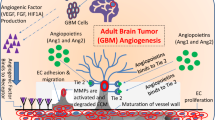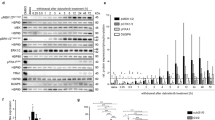Abstract
Glioblastoma (GBM) is an aggressive brain cancer with an average survival rate of 15 months. The composition of the GBM tumor microenvironment—its pH, the presence of growth and immune factors, neurotransmitters, and gliotransmitters—plays an important role in GBM pathophysiology and facilitates tumor survival and growth. In particular, GBM tumor cells produce glutamate, which is toxic to healthy tissue and is associated with increased tumor invasion into adjacent brain regions. The conditions that lead to this excitotoxic release of glutamate are not completely understood. Previous studies have demonstrated that extracellular ATP is present at high levels in the tumor microenvironment, and that ATP stimulates the release of glutamate from astrocytes in culture. Here we examine the functional effects of extracellular ATP on the GL261 cell line, a model system for high-grade astrocytomas such as GBM. We show that treatment with ATP leads to an immediate, dose-dependent influx of calcium into the cell that is partially inhibited by an antagonist (o-ATP) of the ionotropic ATP receptor P2X7. In addition, GL261 cells respond to extracellular ATP with a dose-dependent release of glutamate. Consistent with other reports, we find that ATP is toxic to GL261 cells at high concentrations. Together, these results provide insight into the mechanisms responsible for glutamate production by tumor cells and inform future studies that will identify how the GBM tumor microenvironment facilitates tumor invasion into healthy areas of the brain.





Similar content being viewed by others
References
Omuro A, DeAngelis LM (2013) Glioblastoma and other malignant gliomas: a clinical review. J Am Med Assoc 310:1842–1850
Adamson C, Kanu OO, Mehta AI, Di C, Lin N, Mattox AK, Bigner DD (2009) Glioblastoma multiforme: a review of where we have been and where we are going. Expert Opin Investig Drugs 18:1061–1083
Whiteside TL (2008) The tumor microenvironment and its role in promoting tumor growth. Oncogene 27:5904–5912
Koontongkaew S (2013) The tumor microenvironment contribution to development, growth, invasion and metastasis of head and neck squamous cell carcinomas. J Cancer 4:66–83
Charles NA, Holland EC, Gilbertson R, Glass R, Kettenmann H (2012) The brain tumor microenvironment. Glia 60:502–514
Hanahan D, Weinberg R (2011) Hallmarks of cancer: the next generation. Cell 144:646–674
Grivennikov SI, Greten FR, Karin M (2010) Immunity, inflammation, and cancer. Cell 140:883–899
Pellegatti P, Raffaghello L, Bianchi G, Piccardi F, Pistoia V, Di Virgilio F (2008) Increased level of extracellular ATP at tumor sites: in vivo imaging with plasma membrane luciferase. PLoS ONE 3:1–9
Tamajusuku ASK, Villodre ES, Paulus R, Coutinho-Silva R, Battasstini AMO, Wink MR, Lenz G (2010) Characterization of ATP-induced cell death in the GL261 mouse glioma. J Cell Biochem 109:983–991
de Groot J, Sontheimer H (2011) Glutamate and the biology of gliomas. Glia 59:1181–1189
Morrone FB, Horn AP, Stella J, Spiller F, Sarkis JJF, Salbego CG, Lenz G, Battastini AMO (2005) Increased resistance of glioma cell lines to extracellular ATP cytotoxicity. J Neurooncol 71:135–140
Perea G, Navarrete M, Araque A (2009) Tripartite synapses: astrocytes process and control synaptic information. Trends Neurosci 32:421–431
Ben Achour S, Pascual O (2010) Glia: the many ways to modulate synaptic plasticity. Neurochem Int 57:440–445
Hamilton NB, Attwell D (2010) Do astrocytes really exocytose neurotransmitters? Nat Rev Neurosci 11:227–238
Jeremic A, Jeftinija K, Stevanovic J, Glavaski A, Jeftinija S (2001) ATP stimulates calcium-dependent glutamate release from cultured astrocytes. J Neurochem 77:664–675
Malarkey EB, Parpura V (2008) Mechanisms of glutamate release from astrocytes. Neurochem Int 52:142–154
Ono K, Suzuki H, Higa M, Tabata K, Sawada M (2014) Glutamate release from astrocyte cell-line GL261 via alterations in the intracellular ion environment. J Neural Transm 121:245–257
Leon R, Wu H, Jin Y, Wei J, Buddhala C, Prentice H, Wu JY (2009) Protective function of taurine in glutamate-induced apoptosis in cultured neurons. J Neurosci Res 87:1185–1194
Uberti D, Grilli M, Memo M (2000) Contribution of NF-κB and p53 in the glutamate-induced apoptosis. Int J Dev Neurosci 18:447–454
Manev H, Favaron M, Guidotti A, Costa E (1989) Delayed increase of Ca2+ influx elicited by glutamate: role in neuronal death. Mol Pharmacol 36:106–112
Takano T (2001) Glutamate release promotes growth of malignant gliomas. Nat Med 7:1010–1015
Strong AD, Daniels RL (2017) Live-cell calcium imaging of adherent and non-adherent GL261 cells reveals phenotype-dependent differences in drug responses. BMC Cancer 17:516
Stock K, Kumar J, Synowitz M, Petrosino S, Imperatore R, Smith ESJ, Wend P, Purfürst B, Nuber U, Gurok U, Matyash V, Wälzlein J-H, Chirasani SR, Dittmar G, Cravatt BF, Momma S, Lewin GR, Ligresti A, De Petrocellis L, Cristino L, Di Marzo V, Kettenmann H, Glass R (2012) Neural precursor cells induce cell death of high-grade astrocytomas through stimulation of TRPV1. Nat Med 18:1232–1238
Parpura V, Haydon PG (2000) Physiological astrocytic calcium levels stimulate glutamate release to modulate adjacent neurons. Proc Natl Acad Sci USA 97:8629–8634
Clapham DE (2007) Calcium signaling. Cell 131:1047–1058
Michelangeli F, East JM (2011) A diversity of SERCA Ca2+ pump inhibitors. Biochem Soc Trans 39:789–797
North RA (2002) Molecular physiology of P2X receptors. Physiol Rev 82:1013–1067
Cavaliere F, Amadio S, Sancesario G, Bernardi G, Volonte C (2004) Synaptic P2X7 and oxygen/glucose deprivation in organotypic hippocampal cultures. J Cereb Blood Flow Metab. https://doi.org/10.1097/01.WCB.0000113528.73852.E3
Parvathenani LK, Tertyshnikova S, Greco CR, Roberts SB, Robertson B, Posmantur R (2003) P2X7 mediates superoxide production in primary microglia and is up-regulated in a transgenic mouse model of Alzheimer’s disease. J Biol Chem 278:13309–13317
Lobner D (2000) Comparison of the LDH and MTT assays for quantifying cell death: validity for neuronal apoptosis? J Neurosci Methods 96:147–152
Shen Y, Hu W-W, Fan Y-Y, Dai H-B, Fu Q-L, Wei E-Q, Luo J-H, Chen Z (2007) Carnosine protects against NMDA-induced neurotoxicity in differentiated rat PC12 cells through carnosine-histidine-histamine pathway and H(1)/H(3) receptors. Biochem Pharmacol 73:709–717
Weyermann J, Lochmann D, Zimmer A (2005) A practical note on the use of cytotoxicity assays. Int J Pharm 288:369–376
Lin LH, Chan HL, Chou HC (2012) DNA-dependent protein kinase regulated glioblastoma survival in doxorubicin-induced cytotoxicity. Genom Med Biomark Heal Sci 4:54–56
Sontheimer H (2008) A role for glutamate in growth and invasion of primary brain tumors. J Neurochem 105:287–295
Bridges RJ, Natale NR, Patel SA (2012) System xc– cystine/glutamate antiporter: an update on molecular pharmacology and roles within the CNS. Br J Pharmacol 165:20–34
Abbracchio MP, Burnstock G, Verkhratsky A, Zimmermann H (2009) Purinergic signalling in the nervous system: an overview. Trends Neurosci 32:19–29
Wink MR, Lenz G, Braganhol E, Tamajusuku ASK, Schwartsmann G, Sarkis JJF, Battastini AMO (2003) Altered extracellular ATP, ADP and AMP catabolism in glioma cell lines. Cancer Lett 198:211–218
Di Virgilio F, Adinolfi E (2017) Extracellular purines, purinergic receptors and tumor growth. Oncogene 36:293–303
Burnstock G (2014) Purinergic signalling: from discovery to current developments. Exp Physiol 99:16–34
Vitucci M, Hayes DN, Miller CR (2011) Gene expression profiling of gliomas: merging genomic and histopathological classification for personalised therapy. Br J Cancer 104:545–553
Patel AP, Tirosh I, Trombetta JJ, Shalek AK, Gillespie SM, Wakimoto H, Cahill DP, Nahed BV, Curry WT, Martuza RL, Louis DN, Rozenblatt-Rosen O, Suvà ML, Regev A, Bernstein BE (2014) Single-cell RNA-seq highlights intratumoral heterogeneity in primary glioblastoma. Science 344:1396–1401
Liu G, Yuan X, Zeng Z, Tunici P, Ng H, Abdulkadir IR, Lu L, Irvin D, Black KL, Yu JS (2006) Analysis of gene expression and chemoresistance of CD133+ cancer stem cells in glioblastoma. Mol Cancer. https://doi.org/10.1186/1476-4598-5-67
Amantini C, Mosca M, Nabissi M, Lucciarini R, Caprodossi S, Arcella A, Giangaspero F, Santoni G (2007) Capsaicin-induced apoptosis of glioma cells is mediated by TRPV1 vanilloid receptor and requires p38 MAPK activation. J Neurochem 102:977–990
Acknowledgements
David Dunn provided assistance in establishing glutamate detection assays in our laboratory. Funding for this work was provided by the M.J. Murdock Charitable Trust (Research Start-up Grant for New Science Faculty), the Mountain States Tumor Institute (Small Projects Grant and Summer Fellows Program), and an Institutional Development Award (IDeA) from the National Institute of General Medical Sciences of the National Institutes of Health under Grant #P20GM103408. Its contents are solely the responsibility of the authors and do not necessarily represent the official views of the funding organizations. NIH, M.J. Murdock Charitable Trust, and MSTI had no role in study design, data collection, data analysis and interpretation, decision to publish, or preparation of the manuscript.
Authors’ contributions
ADS, MCI, and NH performed calcium imaging experiments. ADS performed glutamate detection assays and cell viability studies. ADS, MCI, NH, and RLD contributed to study design, data analysis, and drafts of figures. ADS and RLD contributed to drafting the manuscript. RLD edited and finalized figures, figure legends, and manuscript text. ADS, MCI, NH, and RLD read and approved the final manuscript.
Author information
Authors and Affiliations
Corresponding author
Ethics declarations
Conflict of interest
The authors declare that they have no competing interest.
Research involving human and animal rights
This article does not contain any studies with human participants or animals performed by any of the authors.
Rights and permissions
About this article
Cite this article
Strong, A.D., Indart, M.C., Hill, N.R. et al. GL261 glioma tumor cells respond to ATP with an intracellular calcium rise and glutamate release. Mol Cell Biochem 446, 53–62 (2018). https://doi.org/10.1007/s11010-018-3272-5
Received:
Accepted:
Published:
Issue Date:
DOI: https://doi.org/10.1007/s11010-018-3272-5




